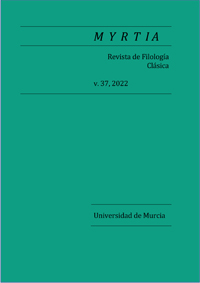Manuel Philes (chap. III, carmen 26 MILLER): exegesis of a cultured scoptic aggression
Abstract
This article aims to examine the content and structural junctions of a Byzantine scoptic poem composed by Manuel Philes (cap. III, carmen 26 Miller). The analysis will focus in particular on the ways and forms of an invective rich in implicit references and polysemic overlaps, in an attempt to grasp the guidelines of a degradation of the adversary that is often affected by contemporary Christian culture.
Downloads
-
Abstract829
-
pdf 465
References
E. Cantarella, 1981, L’ambiguo malanno. Condizione e immagine della donna nell’antichità greca e romana, Roma.
E. Degani, 1972, “Note sulla fortuna di Archiloco e di Ipponatte in epoca ellenistica”, QUCC 16, pp. 79-104.
L. Delatte, 1957, Un office byzantine d’exorcisme, Bruxelles.
U. Eco, R. Lambertini, C. Marmo, A. Tabarroni, 1989, “On Animal Language in the Medieval Classification of Signs”, in On the Medieval Theory of Signs, U. Eco & C. Marmo (edd.), Amsterdam – Philadelphia, pp. 3-38.
P. Gautier, 1980, “Le De daemonibus du Pseudo-Psellos”, REByz 38, pp. 105-194.
A. Giannini, 1963, “Studi sulla paradossografia greca, I. Da Omero a Callimaco: motivi e forme del meraviglioso”, RIL 97, pp. 247-266.
A. Giannini, 1964, “Studi sulla paradossografia greca, II. Da Callimaco all’età imperiale: la letteratura paradosso grafica”, Acme 17, pp. 99-140.
H. Görgemanns, H. Karpp, 1976, Origenes vier Bücher von der Prinzipien, Darmstadt.
C. Jacob, 1983, “De l’art de compiler à la fabricacion du merveilleux. Sur la paradoxografie grecque”, Lalies 2, pp. 121-140.
N. Loraux, 1978, “Sur la race des femmes et quelques-unes de ses tribus”, Arethusa 11, pp. 43-87.
E. V. Maltese, 2006, Dimensioni bizantine. Donne, angeli e demoni nel Medioevo greco, Alessandria.
W. Marg, 1938, Der Charakter in der Sprache der frühgriechischen Dichtung, Würzburg, (rist. Darmstadt 1967).
E. Miller (ed.), 1855-57, Manuelis Philae carmina, 2 vols., Parisiis.
C. Moreschini, 1997, Filosofia e letteratura in Gregorio di Nazianzo, Milano.
E. Pellizer, 1991, “Per una morfologia della poesia giambica arcaica”, in ΟΙΝΗΡΑ ΤΕΥΧΗ. Studi triestini di poesia conviviale, K. Fabian, E. Pellizzer, G. Tedeschi (edd.), Alessandria, pp. 15-29.
PG = J.P. Migne (1857-1866), Patrologiae cursus completus. Series graeca I-CLXI, Parisiis. Cambiano, L. Canfora, D. Lanza (edd.), Roma.
F. Sbordone, 1936, Physiologus (redactio prima), Roma.
G. Schepens, K. Delcroix, 1996, “Ancient Paradoxography: Origin, Evolution, Production and Reception”, in La letteratura di consumo nel mondo greco-latino, O. Pecere, A. Stramaglia (edd.), Cassino, pp. 373-460.
R. Sorabji, 1993, Animal Minds and Human Morals. The Origins of Western Debite, London.
G. Stickler, 1992, Manuel Philes und seine Psalmenmetaphrase, Wien.
A.M. Talbot, 1994, “Epigrams of Manuel Philes on the Theotokos tes Peges and Its Art”, DOP 48, pp. 135-165.
F. Tissoni, 2012, Mille anni di poesia greca. Antologia dei secoli V-XV, Alessandria.
F. Trisoglio, 1986, “La pace in S. Gregorio di Nazianzo”, CCC 2, pp. 193-229.
M. Vegetti, 1979, Il coltello e lo stilo. Animali, schiavi, barbari, donne, alle origini della razionalità scientifica, Milano.
L.G. Westerink (ed.), 1992, Michaelis Pselli Poemata, Stutgardiae et Lipsiae.
E. Pietsch, 2007, “Die Stummheit des Bildes”, JÖByz 57, pp. 135-148.
F. Pradel, 1907, “Griechische und süditalienische Gebete, Beschwörungen und Rezepte des Mittelalters”, Religionsgeschichtliche Versuche und Vorarbeiten 3, 3.
M.M. Sassi, 1993, “Mirabilia”, in Lo spazio letterario della Grecia antica 1, 2, G.
Las obras que se publican en esta revista están sujetas a los siguientes términos:
1. El Servicio de Publicaciones de la Universidad de Murcia (la editorial) conserva los derechos patrimoniales (copyright) de las obras publicadas, y favorece y permite la reutilización de las mismas bajo la licencia de uso indicada en el punto 2.
2. Las obras se publican en la edición electrónica de la revista bajo una licencia Creative Commons Reconocimiento-NoComercial-SinObraDerivada 3.0 España (texto legal). Se pueden copiar, usar, difundir, transmitir y exponer públicamente, siempre que: i) se cite la autoría y la fuente original de su publicación (revista, editorial y URL de la obra); ii) no se usen para fines comerciales; iii) se mencione la existencia y especificaciones de esta licencia de uso.
3. Condiciones de auto-archivo. Se permite y se anima a los autores a difundir electrónicamente las versiones pre-print (versión antes de ser evaluada) y/o post-print (versión evaluada y aceptada para su publicación) de sus obras antes de su publicación, ya que favorece su circulación y difusión más temprana y con ello un posible aumento en su citación y alcance entre la comunidad académica. Color RoMEO: verde.





